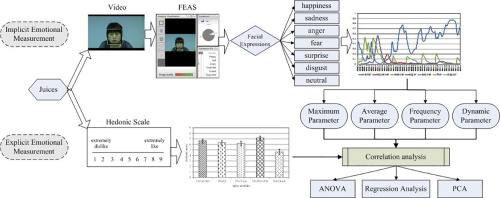Food Research International ( IF 7.0 ) Pub Date : 2018-03-15 , DOI: 10.1016/j.foodres.2018.03.042 Ruicong Zhi , Jingwei Wan , Dezheng Zhang , Weiping Li

|
Emotional reactions towards products play an essential role in consumers' decision making, and are more important than rational evaluation of sensory attributes. It is crucial to understand consumers' emotion, and the relationship between sensory properties, human liking and choice. There are many inconsistencies between Asian and Western consumers in the usage of hedonic scale, as well as the intensity of facial reactions, due to different culture and consuming habits. However, very few studies discussed the facial responses characteristics of Asian consumers during food consumption. In this paper, explicit liking measurement (hedonic scale) and implicit emotional measurement (facial expressions) were evaluated to judge the consumers' emotions elicited by five types of juices. The contributions of this study included: (1) Constructed the relationship model between hedonic liking and facial expressions analyzed by face reading technology. Negative emotions “sadness”, “anger”, and “disgust” showed noticeable high negative correlation tendency to hedonic scores. The “liking” hedonic scores could be characterized by positive emotion “happiness”. (2) Several emotional intensity based parameters, especially dynamic parameter, were extracted to describe the facial characteristic in sensory evaluation procedure. Both amplitude information and frequency information were involved in the dynamic parameters to remain more information of the emotional responses signals. From the comparison of four types of emotional descriptive parameters, the maximum parameter and dynamic parameter were suggested to be utilized for representing emotional state and intensities.
中文翻译:

使用动态情感反应表示的享乐喜好与面部表情测量之间的相关性
对产品的情感反应在消费者的决策中起着至关重要的作用,比对感官属性的合理评估更为重要。了解消费者的情绪以及感官特性,人类喜好和选择之间的关系至关重要。由于文化和消费习惯的不同,亚洲和西方消费者在享乐尺度的使用以及面部反应强度方面存在许多不一致之处。但是,很少有研究讨论食物消费期间亚洲消费者的面部反应特征。在本文中,对显式喜好度(享乐量表)和隐式情绪性测度(面部表情)进行了评估,以判断五种果汁引起的消费者情绪。这项研究的贡献包括:(1)建立了享乐喜好与人脸表情的关系模型,并通过人脸阅读技术进行了分析。负面情绪“悲伤”,“愤怒”和“厌恶”表现出与享乐分数明显的负相关趋势。“喜欢”享乐分数可以通过积极情绪“幸福”来表征。(2)提取了几种基于情绪强度的参数,尤其是动态参数,以描述感官评估过程中的面部特征。振幅信息和频率信息都涉及动态参数,以保持更多的情绪反应信号信息。通过对四种情绪描述参数的比较,建议采用最大参数和动态参数来表示情绪状态和强度。











































 京公网安备 11010802027423号
京公网安备 11010802027423号